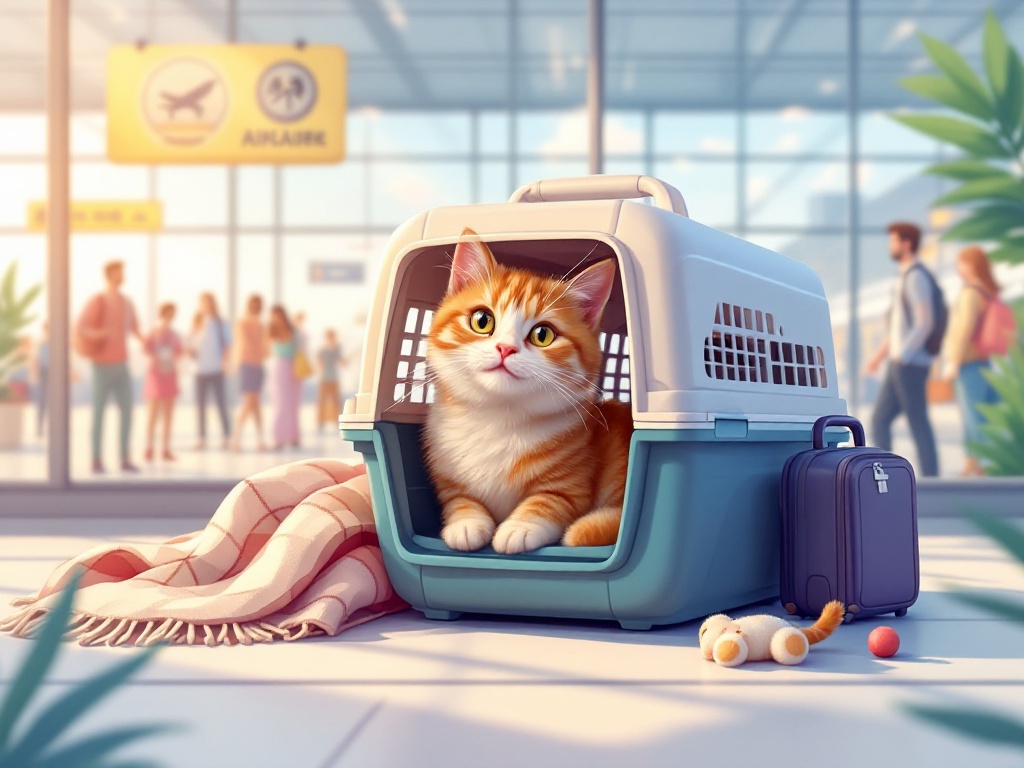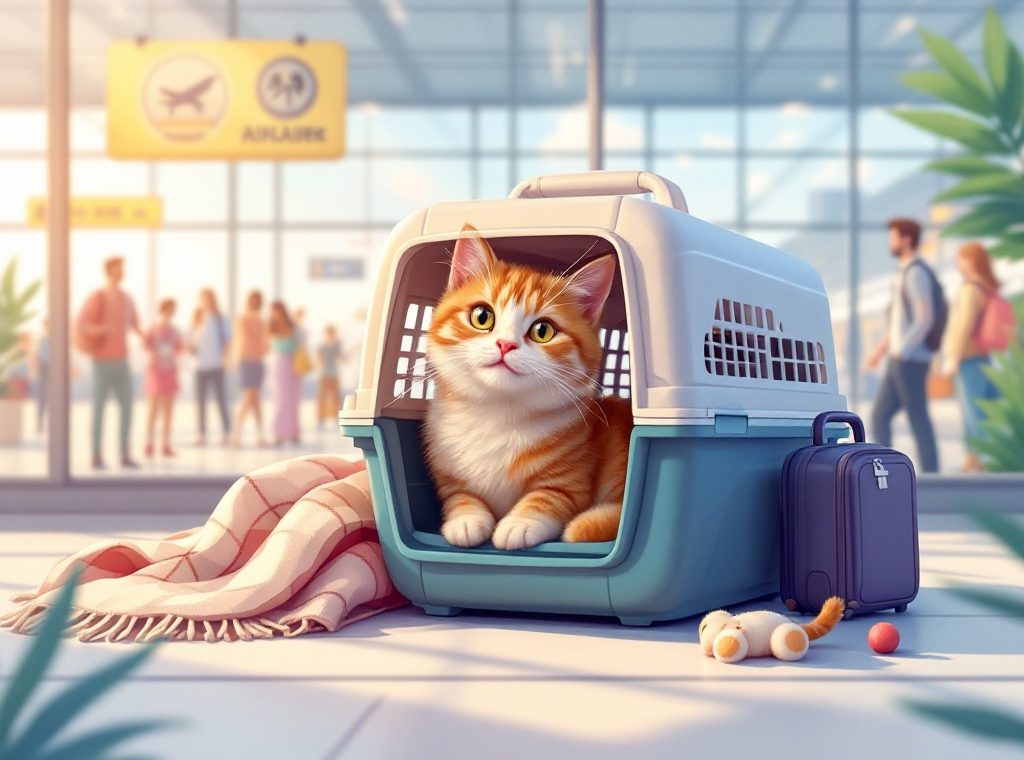Holidays with a Pet: Essential Tips for Traveling with a Cat on a Plane
Planning a holiday trip with your cat? Flying with a feline friend requires careful preparation. Discover essential tips for a smooth journey, from choosing the right airline-approved carrier and understanding airline pet policies to managing your cat’s travel anxiety and navigating airport security. Ensure a stress-free flight for both of you by following our comprehensive guide, covering everything from pre-flight vet checkups and packing essentials to carrier training and calming techniques. Start planning your purr-fect trip today!
Important information

- Book your cat’s flight early, as pet policies and available space vary by airline. Confirm details like size/weight limits and carrier requirements directly with the airline.
- Get your cat used to its carrier well before the trip. Make it comfy with familiar items. Short car rides with the cat in the carrier can reduce travel anxiety.
- Visit your vet for a checkup and necessary health certificates. Discuss calming methods or medications for your cat’s travel anxiety.
- Pack essentials: airline-approved carrier, food, water, bowls, leash, waste bags, medications, comfort items (toy/blanket), updated ID tags, and cleaning supplies.
- At security, remove your cat from the carrier and use a harness or leash. Be aware of airport pet relief areas and airline-specific boarding procedures.
Preparing for Holidays with a Pet
Preparing your cat for holiday air travel requires careful planning. Acclimate your cat to its carrier by leaving it open at home with familiar toys and blankets. Short car rides with your cat in the carrier can also reduce travel anxiety. Schedule a veterinary checkup to ensure your cat is fit to fly and obtain the necessary health certificates. Your vet can also recommend calming techniques. Pack a travel bag with essentials like food, water, bowls, a leash, waste bags, and any medications. Include a favorite toy or blanket for comfort. Finally, ensure your cat’s ID tags are up-to-date and securely attached.
Acclimate your cat to its carrier. Leave the carrier open at home with familiar toys and blankets.
Take short car rides with your cat in the carrier to ease travel anxiety.
Schedule a veterinary checkup to ensure your cat is fit to fly and obtain necessary health certificates. Discuss calming techniques with your vet.
Pack a travel bag with essentials: food, water, bowls, a leash, waste bags, medications, and a favorite toy or blanket.
Ensure your cat’s ID tags are up-to-date and securely attached.
Traveling with a Cat: Essential Preparations
Acclimate your cat to its carrier well in advance of your trip to minimize travel stress.
Make sure the carrier is airline-approved, providing adequate ventilation and security.
Withhold food on the morning of the flight to prevent nausea, but offer small sips of water.
If your cat shows anxiety about flying, consult your veterinarian.
They may suggest medication or calming pheromone sprays for the carrier.
Arranging Pet Travel in Advance
Confirm your cat’s flight details directly with the airline to ensure a smooth journey. Booking early is crucial, as airlines have different rules for pet travel. These rules cover size and weight restrictions, approved carrier types, and whether your cat can travel in the cabin or cargo area. Pet space is often limited, so book your cat’s spot as soon as possible.
Understanding Airline Pet Policies
Traveling with your cat? Airlines typically allow cats in the cabin or as checked baggage, but regulations vary. Before booking, review the airline’s pet policy, including carrier size, ventilation, health certificates, and required vaccinations. Pet fees also differ between airlines. For a less stressful trip for your cat, consider a direct flight. Here’s a step-by-step guide:
Check the airline’s pet policy. Every airline has specific rules concerning pet travel, so it’s crucial to review them before booking your flight.
Confirm carrier requirements. Airlines have specific regulations regarding carrier size and ventilation to ensure your cat’s safety and comfort during the flight.
Ensure your cat has the necessary health documentation. Most airlines require a health certificate from a veterinarian and proof of certain vaccinations.
Inquire about pet fees. Pet travel fees vary between airlines, so it’s essential to factor this into your budget. Contact the airline directly to determine the exact cost.
Consider booking a direct flight. Direct flights minimize travel time and reduce stress on your cat, making the journey more comfortable.
Checking Airline Regulations for Cats
Before booking your flight, review your airline’s pet policy, as not all airlines permit cats in the cabin. Some airlines impose restrictions on breeds, sizes, and carrier dimensions. Booking early is recommended, as cabin space for pets is often limited. Be prepared, as your airline might require health documentation for your cat.
Airline Pet Travel Policies and Paperwork
Planning a trip with your furry friend? Airlines require specific documentation for pet travel, typically a health certificate from your veterinarian. Because airline policies vary, contacting your chosen airline directly is crucial to confirm their precise requirements before your departure. This will help ensure a stress-free journey for both of you.
Pet Travel Essentials for Air Travel
Traveling with your cat requires preparation. A vet’s health certificate with up-to-date vaccinations is essential. Secure an airline-approved carrier that’s comfortable for your cat. Pack essentials: food, water, bowls, medications, health/vaccination records, a leash, waste bags, and a familiar toy or blanket. Direct flights are preferable. Ensure both your cat and carrier have ID tags. Bring cleaning supplies for accidents.
Obtain a vet’s health certificate. Ensure your cat’s vaccinations are current.
Choose an airline-approved carrier that provides ample space for your cat to move comfortably.
Pack essential items: food and water bowls, sufficient food and bottled water, any necessary medications, copies of your cat’s health and vaccination records, a leash, and waste bags.
Book direct flights whenever possible to minimize stress for your cat.
Ensure both your cat and the carrier have identification tags.
Pack a familiar blanket or toy and cleaning supplies for a smoother journey.
Health and Vaccination Certificates
Traveling with your cat? Whether your destination is domestic or international, consult your veterinarian about health certificate requirements. They can advise on necessary vaccinations and any regulations specific to your destination. International travel involves additional steps and paperwork, so plan ahead.
Pet ID Tags and Microchipping
Pet ID tags offer a fast way to access vital contact information, but microchips provide a permanent solution that significantly increases the likelihood of a lost cat’s safe return. This tiny electronic device, implanted under the skin, offers secure and lasting identification.
Choosing the Right Cat Carrier
Traveling with your cat? A suitable carrier is a must. Ensure it’s airline-approved, secure, and well-ventilated, providing enough space for your cat to stand, turn, and lie down comfortably. A soft-bottomed carrier with a familiar blanket can soothe your cat during the flight. Confirm your airline’s specific size and other requirements before traveling.
Airline-Approved Cat Carriers
Traveling with your cat? Make sure your carrier complies with airline regulations. These rules vary by airline. Generally, the carrier should fit under the seat in front of you. It must have enough ventilation for your cat to stand, turn, and lie down comfortably. Specific size and other restrictions may apply. Check your airline’s website for detailed requirements to ensure a smooth trip for you and your furry friend.
Ensuring Comfort: Soft-Sided vs. Hard-Sided Carriers
Soft-sided carriers offer more flexibility and comfort.
A comfortable carrier can significantly reduce stress during air travel.
Hard-sided carriers provide better protection.
Choosing the right carrier is essential for your cat’s well-being, especially during air travel.
Ensuring Cat Comfort and Safety During Travel
Introducing your pet to the carrier should be a gradual and positive process. Place familiar items like favorite toys and blankets inside to create a comforting and safe space. Short trips can help your pet acclimate to the carrier and build positive associations. Calming sprays or pheromones can also help reduce anxiety during travel. Consult your veterinarian about feeding schedules before and during your trip, and always ensure fresh water is available in a collapsible travel bowl.
Carrier Training and Familiarization
Introduce your cat’s carrier in a quiet, cozy corner of your home, leaving the door open and placing a familiar blanket or toy inside. This creates a positive connection with the carrier. Encourage exploration with treats and praise, reinforcing positive associations. Gradually extend the time your cat spends inside. Begin with short drives, like a quick trip around the block, to acclimate your cat to both the carrier and car travel. This method significantly reduces travel-related stress.
Introduce the carrier in a quiet space. Place the carrier in a quiet, cozy corner of your home, leaving the door open.
Make it comfortable. Place a familiar blanket or toy inside to create a positive connection with the carrier.
Encourage exploration. Encourage your cat to explore the carrier with treats and praise, reinforcing positive associations.
Increase carrier time. Gradually extend the time your cat spends inside the carrier.
Start with short trips. Begin with short drives, like around the block, to acclimate your cat to the carrier and car.
Using Calming Sprays and Familiar Smells
To ease your cat’s travel anxiety, consider using a calming spray, such as a pheromone spray. Familiar scents from a favorite blanket or toy placed inside the carrier can also create a comforting environment, making the journey less stressful.
Feeding and Hydration Guidelines for Cats
Withhold food on the morning of your cat’s flight to help prevent motion sickness. Ensure they are well-hydrated beforehand, as this is crucial for a comfortable trip.
Addressing Cat Anxiety and Stress
Signs of Stress in Cats:
- excessive meowing,
- excessive grooming,
- hiding,
- aggression,
- altered appetite,
- inappropriate urination,
- flattened ears,
- tucked tail.
Medication for Travel Stress
Consult your veterinarian about anti-anxiety medication for your cat. They can determine the appropriate dosage and discuss potential side effects based on your cat’s health and the trip’s duration.
Non-Medicinal Options
Consider Feliway pheromone sprays or diffusers to reduce your cat’s anxiety naturally.
Recognizing Signs of Stress in Cats
Cats exhibit stress through various behaviors, such as hiding, excessive meowing, aggression, and altered litter box habits. Changes in their eating patterns can also indicate stress. If your cat displays these signs, air travel might be the cause. Consider exploring alternative travel arrangements.
Vet Recommendations for Anti-Anxiety Medications
Talk to your veterinarian about anti-anxiety medication to ease your cat’s travel stress. This can make the journey more comfortable for both of you.
Navigating Security and Boarding with Your Cat
Traveling with your cat requires careful planning. Here’s a step-by-step guide to ensure a smooth journey:
Security Screening
The TSA mandates that all cats be removed from their carriers during the security screening process. A secure leash or harness is essential to prevent your cat from escaping. Inform TSA agents about any special needs your cat may have.
Pet Relief Areas
While some airports offer pet relief areas post-security, availability varies. Check the airport’s website or contact customer service to confirm the availability of these facilities.
Boarding Procedures
Boarding procedures for pets differ by airline. Some airlines may allow you to board early with your pet, while others may require pet owners to board last. Contact your airline in advance to understand their specific pet boarding procedures.
Flight Delays
Be prepared for potential flight delays, which can be stressful for both you and your cat. Pack extra food, water, and any necessary medications to ensure your cat’s comfort during unexpected delays.
Security Check Procedures with Pets
When going through airport security, take your pet out of its carrier and secure it with a harness or leash. This precaution ensures its safety during the screening process.
Using a Cat Harness for Safety
A cat harness offers increased control and security in the bustling airport environment, proving especially beneficial for easily stressed felines. It prevents escapes during security checks and boarding, keeping your cat safe and sound.












